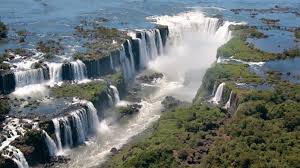
The reputation of Rio de Janeiro precedes it. This is the home of the world’s most exuberant carnival, a city that fronts two world-famous beaches – Copacobana and Ipanema. It is a heady mix of rampant partying and ‘dental floss’ bikinis, where glamour rubs shoulders with crime-ridden favela shantytowns, and all beneath the outstretched arms of the giant statue Christ the Redeemer. Most of all, the natural beauty of Rio captures the hearts of visitors.
In order to appreciate the spectacular beauty, one can go to the base of Christ the Redeemer, on the crest of the Corvocado peak. Below, in an amphitheatre of ragged hills and mountains, the city hugs the plains, clustering around the beaches and the large lagoon, Lagoa Rodrigo de Freitas, and everywhere is punctuated with dramatic hills, including the Suagr Loaf Mountain which you can take a cable car across. The city barely seems able to keep nature at bay, with the rocky peaks surrounded by a froth of luxuriant greenery. Indeed, Rio de Janeiro is home to the world’s largest urban rainforest, the Parque Nacional de Tijuca.
The city centre lies to the north, away from upmarket Copacobana and Ipanema, overlooking the mouth of the deep inlet called Guanabara Bay. This is where the main institutions are clustered, including the Museu Nacional and Museu Historico Nacional. The grand Museu Nacional de Belas Artes contains Brazil’s prime art collection, but the bridge across the bay to Nitteroi leads to Rio’s most eyecatching arts centre, the Museu de Arte Contemporanea (MAC). Inaugurated in 1996, it has a dics-like form of an alien spaceship – underlining the exceptional beauty of Rio’s natural backdrop through the sheer boldness of its contrast.

A little bit about the origins of Rio de Janeiro. Approaching from the sea in January (Janeiro) 1502, Portugese explorers thought the mouth of Guanabara Bay was the estuary of a mighty river (rio). The French came in 1555 and occupied an island in the bay, then battled with the Portugese, who in 1565, set up their own fort and eventually prevailed. Rio gained its status in 1808, when the Portugese royal family settled down here. For 13 years, Rio was the royal capital of Portugal and Brazil, until a rebellion after 1870 led to an overthrow of the monarchy and in 1889 Brazil became a republic.



